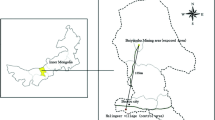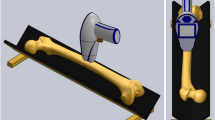Abstract
This study was undertaken to provide reference values of chemical element mass fractions in intact bone of Reference (European Caucasian) Man/Woman. The rib bone samples investigated were obtained from autopsies of 84 apparently healthy 15–58-year-old citizens (38 females and 46 males) of a non-industrial region in the Central European part of Russia who had suffered sudden death. The mass fractions (mg/kg given on a wet mass basis) of 69 elements in these bone samples were measured by using neutron activation analysis with high-resolution spectrometry of short-lived and long-lived radionuclides, particle-induced gamma-ray emission, inductively coupled plasma atomic emission spectrometry, and inductively coupled plasma mass spectrometry including necessary quality control measures. Using published and measured data, mass fraction values of the 79 elements for the rib bone have been derived. Based on accepted rib to skeleton mass fractions and reference values of skeleton mass for Reference Man, the elemental burdens in the skeleton were estimated. These results may provide a representative bases for establishing related reference values for the Russian Reference Man/Woman and for revising and adding current reference values for the International Commission on Radiological Protection. The data presented will also be very valuable for many other applications in radiation protection, radiotherapy radiation dosimetry, and other scientific fields.
Similar content being viewed by others
References
Anke M, Schneider H-J, Grun M, Groppel B, Hennig A (1978) Die Diagnose des Mangan-, Zink- und Kupfermangels und der Kadmiumbelastung. Zbl Pharm 117:688–705
Bacso J, Balazs D, Uzonyi I, Lusztig G, Szigety I (1993) Study of relationships between micro element contents of human hair and other tissues in connection with environmental contamination and some diseases. In: The significance of hair mineral analysis as a means for assessing internal body burdens of environmental pollutants. Report on an IAEA Co-ordinated research programme (NAHRES-18). IAEA, Vienna, pp 5–26
Bowen HJM (1966) Trace elements in biochemistry. Academic Press, London
Bowen HJM (1979) Environmental chemistry of the elements. Academic Press, London
Brättter P, Gawlik D, Lausch J, Rosick U (1977) On the distribution of the trace elements in human skeletons. J Radioanal Chem 37:393–403
Byrne AR, Kosta L (1978) Vanadium in foods and in human body fluids and tissues. Sci Total Environ 10:17–30
Crawford MD, Crawford T (1969) Lead content of bones in a soft and hard water area. Lancet 7597:699–701
Ermakova EV, Frontasyeva MV, Pavlov SS, Povtoreiko EA, Steinnes E, Cheremisina YeN (2004) Air pollution studies in Central Russia (Tver and Yaroslavl regions) using the moss biomonitors technique and neutron activation analysis. J Atmos Chem 49:549–561
Forssen A (1972) Inorganic elements in the human body. Ann Med Exp Biol Fenniae 50:99–162
GOST18622-79 (1981) Interaction between the ionizing radiation and materials. Chemical composition of a tissue-equivalent material, Moscow
Grynpas MD, Pritzker KPH, Hancock RGV (1987) Neutron activation analysis of bulk and selected trace elements in bone using low flux SLOWPOKE reactor. Biol Trace Elem Res 13:333–334
Hamilton EI (1979) The chemical elements and man. Charles C Thomas Publisher, USA
ICRP-23 (International Commission on Radiological Protection) (1975) Report of the task group on Reference Man, Publication 23. Pergamon Press, Oxford
ICRP-89 (International Commission on Radiological Protection) (2002) Annals of the ICRP. Basic Anatomical and Physiological Data for Use in Radiological Protection: Reference Values, Publication 89. Pergamon Press, New York
Iyengar GV (1998) Reevaluation of the trace element content in Reference Man. Radiat Phys Chem 51:545–560
Iyengar GV, Tandon L (1999) Minor and trace elements in human bones and teeth (NAHRES-39). IAEA, Vienna
Iyengar G, Kollmer WE, Bowen HJM (1978) The elemental composition of human tissues and body fluids. A compilation of values for adults, Verlag Chemie
Jaritz M, Anke M, Holzinger S (1998) Der Bariumgehalt verschiedener Organe von Feldhase, Wildschwein, Damhirsch, Reh, Rothirsch, Mufflon und Mensch. In: Anke M, Arnold W, Bergmann H et al (eds) Mengen- und Spurenelemente. 18 Arbeitstagung. Friedrich-Schiller-Universitat, Jena, pp 467–474
Kehoe RA, Cholak J, Story RV (1940) A spectrochemical study of the normal ranges of concentrations of certain trace metals in biological materials. J Nutr 19:579–588
Koch HJ, Smith ER, Shimp NF, Connor J (1956) Analysis of trace elements in human tissue I. Normal tissues. Cancer 9:499–511
Koch HJ, Smith ER, McNeely J (1957) Analysis of trace elements in human tissues II. The lymphomatous disease. Cancer 10:151–160
Moskalev YuI (1985) Mineral metabolism. Meditsina, Moscow
Nusbaum RE, Butt EM, Gilmour TC, Di Dio SL (1965) Relation of air pollution to trace metals in bone. Arch Environ Health 10:227–232
Parr R (1982) Inter-comparison of minor and trace elements in IAEA Animal bone (H-5), Progress Report No.1. IAEA, Vienna
Patti F, Garcet M, Jeanmaire L (1984) Concentration of stable zinc in human bones. Determination by X-ray fluorescence spectrography. Sci Total Environ 39:71–79
Saiki S, Takata MK, Kramarski S, Borelli A (1999) Instrumental neutron activation analysis of rib bone samples and of bone reference materials. Biol Trace Elem Res 71–72:41–46
Samudralwar DL, Robertson JD (1993) Determination of major and trace elements in bones by simultaneous PIXE/PIGE analysis. J Radioanal Nucl Chem, Articles 169:259–267
Sastri CS, Iyengar V, Blondiaux G, Tessier Y, Petri H, Hoffmann P, Aras NK, Zaichick V, Ortner HM (2001) Fluorine determination in human and animal bones by particle-induced gamma-ray emission. Fresenius J Anal Chem 370:924–929
Schneider HJ, Anke M (1971) Die Abhängigkeiten des Kalzium-, Phosphor- und Mangangehaltes verschiedener Organe des Menschen. Arch Exper Vet Med 25:787–792
Schroeder HA, Tipton IH, Nason AP (1972) Trace metals in man: strontium and barium. J Chronic Dis 25:491–517
Schuhmacher M, Domingo JL, Llobet JM, Corbella J (1992) Levels of same trace elements in autopsy tissues from subjects living in Tarragona province, Spain. In: Anastassopoulou J, Collery Ph, Etienne JC et al (eds) Metal ions in biology and medicine, vol 2. John Libbey Eurotext, Paris, pp 430–431
Sowden EM, Stitch SR (1957) Trace elements in human tissue. 2. Estimation of the concentrations of stable strontium and barium in human bone. Biochem J 67:104–109
Sumino K, Hayakawa K, Shibata T, Kitamura S (1975) Heavy metals in normal Japanese tissues. Arch Environ Health 30:487–494
Suzuki Y (1979) The normal levels of fluorine in the bone tissue of Japanese subjects. Tohoku J Exp Med 129:327–336
Takata MK, Saiki M, Sumita NM, Saldova PHN, Pasqualucci CA (2005) Trace element determinations in human cortical and trabecular bones. J Radioanal Nucl Chem 264:5–8
Tanaka G, Kawamura H, Nomura E (1981) Distribution of strontium in the skeleton and in the mass of mineralized bone. Health Phys 40:601–614
Tipton IH, Johns JC, Boyd M (1968) The variation with age of elemental concentrations in human tissue. In: Proceedings First International Congress of Radiation Protection. Pergamon, Elmsford-NY, p 759
Tzaphlidou M, Zaichick V (2003) Calcium, phosphorus, calcium-phosphorus ratio in rib bone of healthy humans. Biol Trace Elem Res 93:63–74
Utsumi M, Tohno S, Minami T, Okazaki Y, Moriwake Y, Yamada M, Tohno Y (1999) Age-independent constancy of mineral contents in human ribs. Biol Trace Elem Res 67:165–171
Woodard HQ, White DR (1982) Bone models for use in radiotherapy dosimetry. Brit J Radiol 55:277–282
Yoshinaga J, Suzuki T, Morita M (1989) Sex- and age-related variation in elemental concentrations of contemporary Japanese ribs. Sci Total Environ 79:209–221
Yoshinaga J, Suzuki T, Morita M, Hayakawa M (1995) Trace elements in ribs of elderly people and elemental variation in the presence of chronic diseases. Sci Total Environ 162:239–252
Zaichick V (1995) Application of synthetic reference materials in the medical radiological research centre. Fresenius J Anal Chem 352:219–223
Zaichick V (1997) Sampling, sample storage and preparation of biomaterials for INAA in clinical medicine, occupational and environmental health. Harmonization of health-related environmental measurements using nuclear and isotopic techniques. IAEA, Vienna, In, pp 123–133
Zaichick V (2004a) Losses of chemical elements in biological samples under the dry aching process. Trace Elem Med 5:17–22
Zaichick V (2004b) INAA application in the age dynamics assessment of Ca, Cl, K, Mg, Mn, Na, P, and Sr contents in the cortical bone of human femoral neck. J Radioanal Nucl Chem 259:351–354
Zaichick V (2006a) NAA of Ca, Cl, K, Mg, Mn, Na, P, and Sr contents in the human cortical and trabecular bone. J Radioanal Nucl Chem 269:653–659
Zaichick V (2006b) Medical elementology as a new scientific discipline. J Radioanal Nucl Chem 269:303–309
Zaichick V (2007) INAA application in the assessment of selected elements in cancellous bone of human iliac crest. J Radioanal Nucl Chem 271:573–576
Zaichick V, Zaichick S (2009) Instrumental neutron activation analysis of trace element contents in the rib bone of healthy men. J Radioanal Nucl Chem 281:47–52
Zaichick S, Zaichick V (2010) Human bone as a biological material for environmental monitoring. Int J Environ Health 4:278–292
Zaichick V, Dyatlov A, Zaichick S (2000) INAA application in the age dynamics assessment of major, minor, and trace elements in the human rib. J Radioanal Nucl Chem 244:189–193
Zaichick V, Zaichick S, Karandashev V, Nosenko S (2009) The effect of age and gender on Al, B, Ba, Ca, Cu, Fe, K, Li, Mg, Mn, Na, P, S, Sr, V, and Zn contents in rib bone of healthy humans. Biol Trace Elem Res 129:107–115
Zaichick S, Zaichick V, Karandashev V, Moskvina I (2011a) The effect of age and gender on 59 trace element contents in human rib bone investigated by inductively coupled plasma mass spectrometry. Biol Trace Elem Res 143:41–57
Zaichick S, Zaichick V, Karandashev V, Nosenko S (2011b) Accumulation of rare earth elements in human bone within the lifespan. Metallomics 3:186–194
Zhang ZhH, Chai ZF, Mao XY, Chen JB (2003) Biomonitoring trace element atmospheric deposition using lichens in China. In: Biomonitoring of atmospheric pollution (with emphasis on trace elements)—BioMAPII. IAEA-TECDOC-1338. IAEA, Vienna, pp 229–234
Zhu H, Wang N, Zhang Y, Wu Q, Chen R, Gao J, Chang P, Liu Q, Fan T, Li J, Wang J, Wang J (2010) Element contents in organs and tissues of chinese adult men. Health Phys 98:61–73
Zipkin I, McClure FJ, Leone NC, Lee WA (1985) Fluoride deposition in human bones after prolonged ingestion of fluoride in drinking water. US Public Health Rep 73:732–740
Zwanziger H (1989) The multielemental analysis of bone: a review. Biol Trace Elem Res 19:195–223
Author information
Authors and Affiliations
Corresponding author
Additional information
Dedicated to the blessed memory of my good friend Prof. Dr. Friedrich Grass (Atominstitut der Österreichischen Universitäten, Wien), who was the leading scientist in the field of modern nuclear analytical methods in the second part of the twentieth century.
Rights and permissions
About this article
Cite this article
Zaichick, V. Data for the Reference Man: skeleton content of chemical elements. Radiat Environ Biophys 52, 65–85 (2013). https://doi.org/10.1007/s00411-012-0448-3
Received:
Accepted:
Published:
Issue Date:
DOI: https://doi.org/10.1007/s00411-012-0448-3




